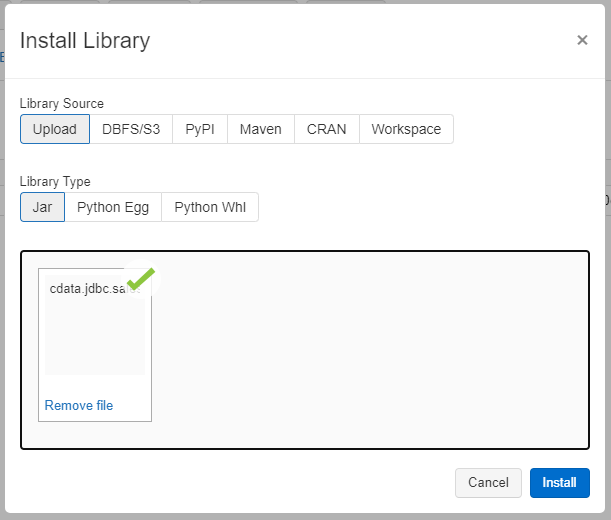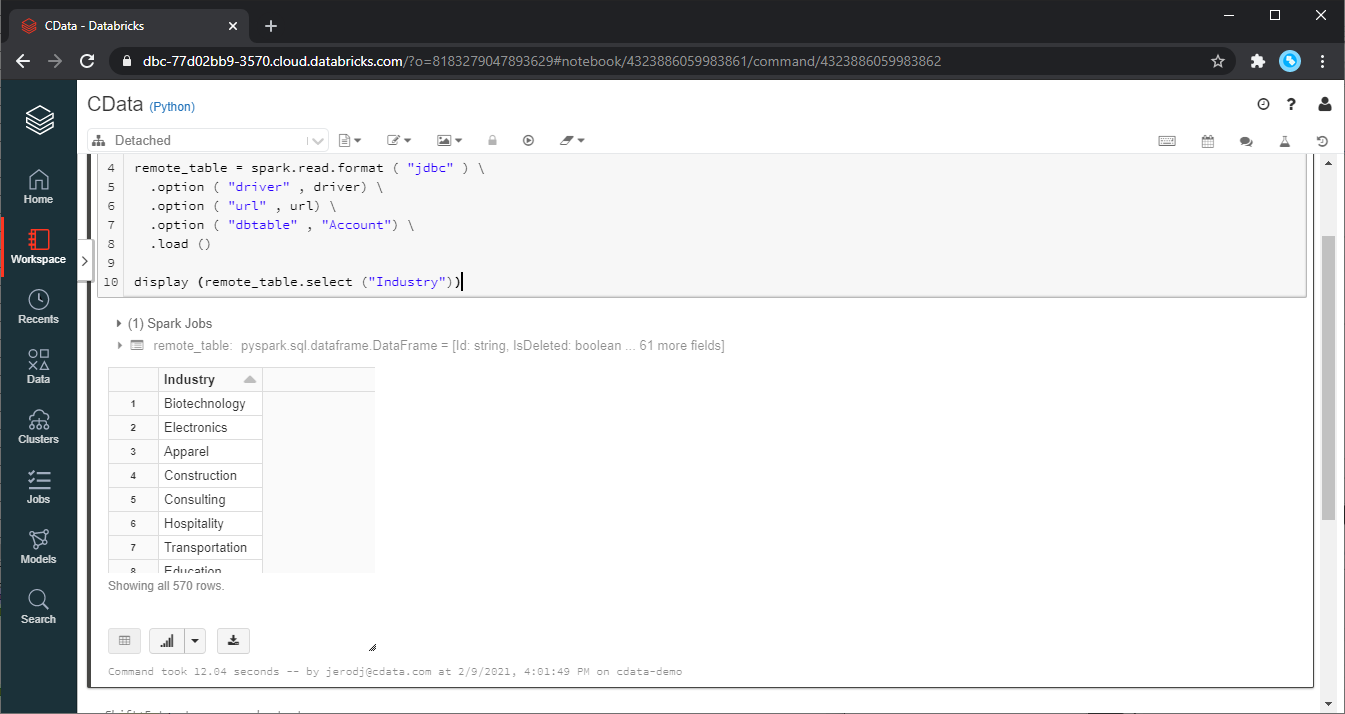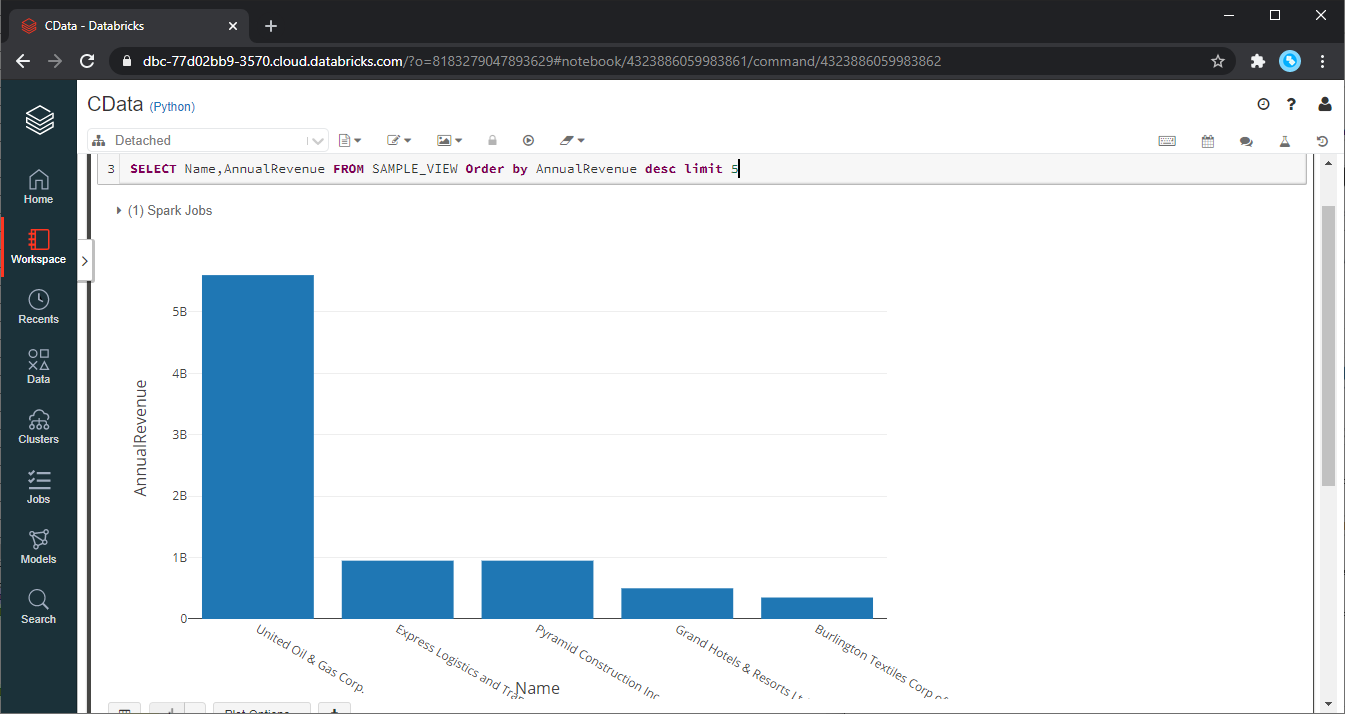Discover how a bimodal integration strategy can address the major data management challenges facing your organization today.
Get the Report →Process & Analyze IBM Cloud Object Storage Data in Databricks (AWS)
Host the CData JDBC Driver for IBM Cloud Object Storage in AWS and use Databricks to perform data engineering and data science on live IBM Cloud Object Storage data.
Databricks is a cloud-based service that provides data processing capabilities through Apache Spark. When paired with the CData JDBC Driver, customers can use Databricks to perform data engineering and data science on live IBM Cloud Object Storage data. This article walks through hosting the CData JDBC Driver in AWS, as well as connecting to and processing live IBM Cloud Object Storage data in Databricks.
With built-in optimized data processing, the CData JDBC Driver offers unmatched performance for interacting with live IBM Cloud Object Storage data. When you issue complex SQL queries to IBM Cloud Object Storage, the driver pushes supported SQL operations, like filters and aggregations, directly to IBM Cloud Object Storage and utilizes the embedded SQL engine to process unsupported operations client-side (often SQL functions and JOIN operations). Its built-in dynamic metadata querying allows you to work with and analyze IBM Cloud Object Storage data using native data types.
Install the CData JDBC Driver in Databricks
To work with live IBM Cloud Object Storage data in Databricks, install the driver on your Databricks cluster.
- Navigate to your Databricks administration screen and select the target cluster.
- On the Libraries tab, click "Install New."
- Select "Upload" as the Library Source and "Jar" as the Library Type.
- Upload the JDBC JAR file (cdata.jdbc.ibmcloudobjectstorage.jar) from the installation location (typically C:\Program Files\CData[product_name]\lib).

Access IBM Cloud Object Storage Data in your Notebook: Python
With the JAR file installed, we are ready to work with live IBM Cloud Object Storage data in Databricks. Start by creating a new notebook in your workspace. Name the notebook, select Python as the language (though Scala is available as well), and choose the cluster where you installed the JDBC driver. When the notebook launches, we can configure the connection, query IBM Cloud Object Storage, and create a basic report.
Configure the Connection to IBM Cloud Object Storage
Connect to IBM Cloud Object Storage by referencing the JDBC Driver class and constructing a connection string to use in the JDBC URL. Additionally, you will need to set the RTK property in the JDBC URL (unless you are using a Beta driver). You can view the licensing file included in the installation for information on how to set this property.
Step 1: Connection Information
driver = "cdata.jdbc.ibmcloudobjectstorage.IBMCloudObjectStorageDriver" url = "jdbc:ibmcloudobjectstorage:RTK=5246...;ApiKey=myApiKey;CloudObjectStorageCRN=MyInstanceCRN;Region=myRegion;OAuthClientId=MyOAuthClientId;OAuthClientSecret=myOAuthClientSecret;"
Built-in Connection String Designer
For assistance in constructing the JDBC URL, use the connection string designer built into the IBM Cloud Object Storage JDBC Driver. Either double-click the JAR file or execute the jar file from the command-line.
java -jar cdata.jdbc.ibmcloudobjectstorage.jar
Fill in the connection properties and copy the connection string to the clipboard.
Register a New Instance of Cloud Object Storage
If you do not already have Cloud Object Storage in your IBM Cloud account, follow the procedure below to install an instance of SQL Query in your account:
- Log in to your IBM Cloud account.
- Navigate to the page, choose a name for your instance and click Create. You will be redirected to the instance of Cloud Object Storage you just created.
Connecting using OAuth Authentication
There are certain connection properties you need to set before you can connect. You can obtain these as follows:
API Key
To connect with IBM Cloud Object Storage, you need an API Key. You can obtain this as follows:
- Log in to your IBM Cloud account.
- Navigate to the Platform API Keys page.
- On the middle-right corner click "Create an IBM Cloud API Key" to create a new API Key.
- In the pop-up window, specify the API Key name and click "Create". Note the API Key as you can never access it again from the dashboard.
Cloud Object Storage CRN
If you have multiple accounts, you will need to specify the CloudObjectStorageCRN explicitly. To find the appropriate value, you can:
- Query the Services view. This will list your IBM Cloud Object Storage instances along with the CRN for each.
- Locate the CRN directly in IBM Cloud. To do so, navigate to your IBM Cloud Dashboard. In the Resource List, Under Storage, select your Cloud Object Storage resource to get its CRN.
Connecting to Data
You can now set the following to connect to data:
- InitiateOAuth: Set this to GETANDREFRESH. You can use InitiateOAuth to avoid repeating the OAuth exchange and manually setting the OAuthAccessToken.
- ApiKey: Set this to your API key which was noted during setup.
- CloudObjectStorageCRN (Optional): Set this to the cloud object storage CRN you want to work with. While the connector attempts to retrieve this automatically, specifying this explicitly is recommended if you have more than Cloud Object Storage account.
When you connect, the connector completes the OAuth process.
- Extracts the access token and authenticates requests.
- Saves OAuth values in OAuthSettingsLocation to be persisted across connections.

Load IBM Cloud Object Storage Data
Once you configure the connection, you can load IBM Cloud Object Storage data as a dataframe using the CData JDBC Driver and the connection information.
Step 2: Reading the data
remote_table = spark.read.format ( "jdbc" ) \ .option ( "driver" , driver) \ .option ( "url" , url) \ .option ( "dbtable" , "Objects") \ .load ()
Display IBM Cloud Object Storage Data
Check the loaded IBM Cloud Object Storage data by calling the display function.
Step 3: Checking the result
display (remote_table.select ("Key"))

Analyze IBM Cloud Object Storage Data in Databricks
If you want to process data with Databricks SparkSQL, register the loaded data as a Temp View.
Step 4: Create a view or table
remote_table.createOrReplaceTempView ( "SAMPLE_VIEW" )
With the Temp View created, you can use SparkSQL to retrieve the IBM Cloud Object Storage data for reporting, visualization, and analysis.
% sql SELECT Key, Etag FROM SAMPLE_VIEW ORDER BY Etag DESC LIMIT 5

The data from IBM Cloud Object Storage is only available in the target notebook. If you want to use it with other users, save it as a table.
remote_table.write.format ( "parquet" ) .saveAsTable ( "SAMPLE_TABLE" )
Download a free, 30-day trial of the CData JDBC Driver for IBM Cloud Object Storage and start working with your live IBM Cloud Object Storage data in Databricks. Reach out to our Support Team if you have any questions.






